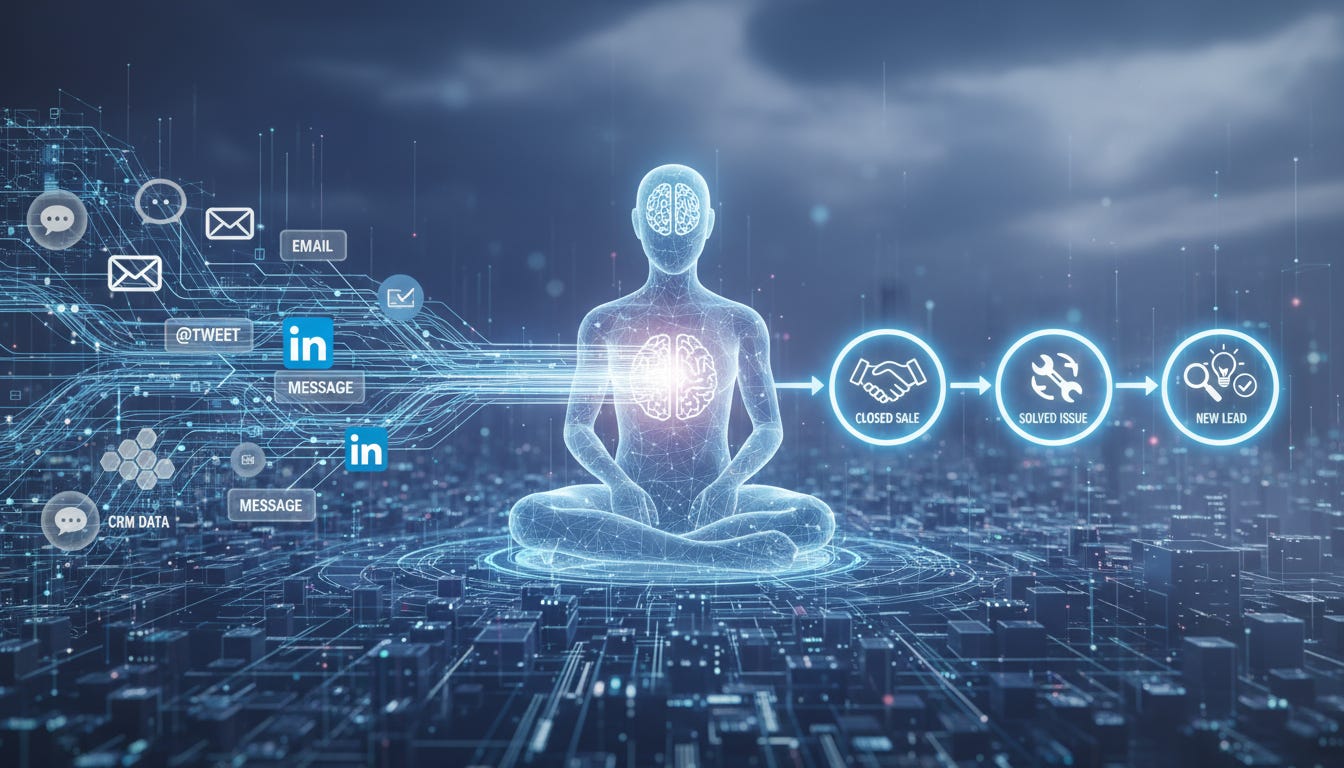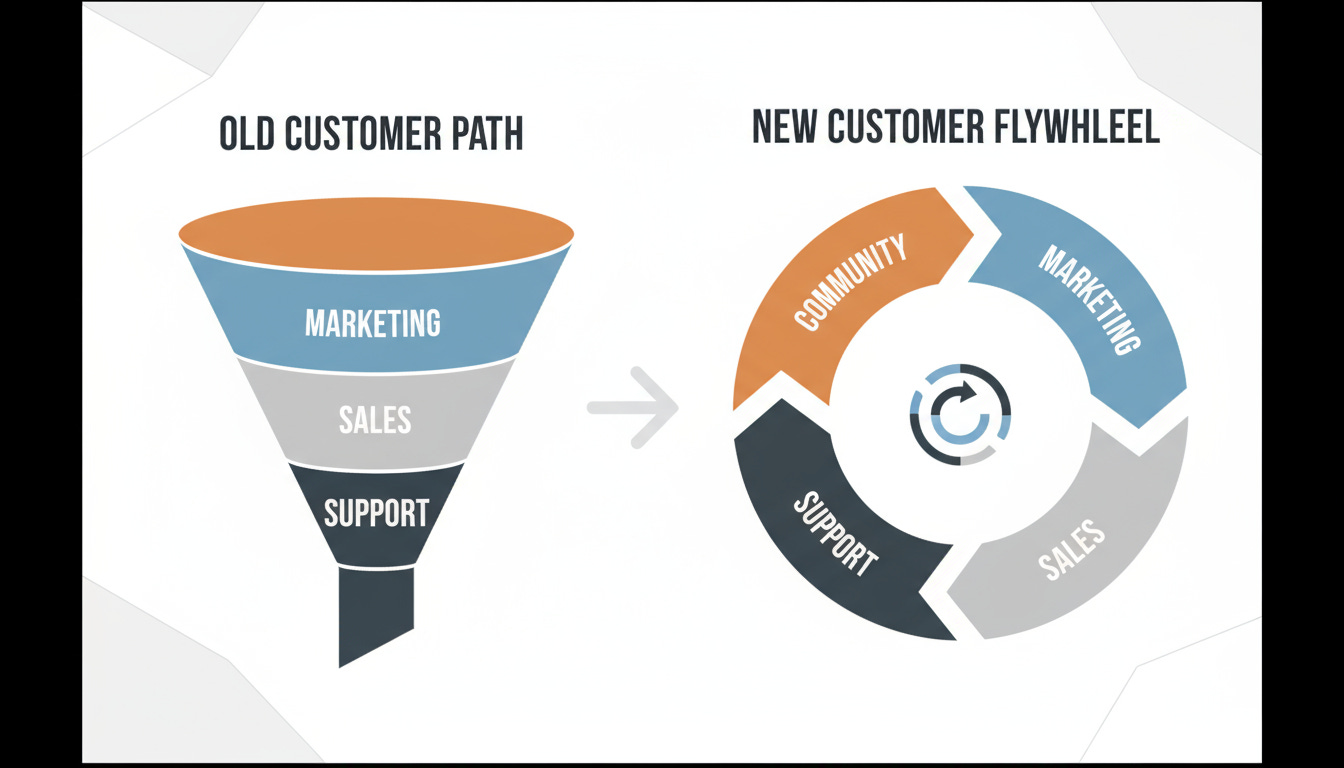The Next Frontier of Data Moats, Verticals Mashing Together, & The Perils of Generative-Only Apps
In this edition, we explore the changing tides of data, how functions within companies are mashing together, and a contrarian take on new social generative media apps.
Edition #36 of Implications.
This edition explores forecasts and implications around: (1) the growing ubiquity of data and what new forms of data may prove valuable, (2) the collapse of social, sales, and support functions into one — and the perils of seat-based business models, (3) why generative-only social apps will struggle with retention, and (4) some surprises at the end, as always.
If you’re new, here’s the rundown on what to expect. This ~monthly analysis is written for founders + investors I work with, colleagues, and a select group of subscribers. I aim for quality, density, and provocation vs. frequency and trendiness. We don’t cover news; we explore the implications of what’s happening. My goal is to ignite discussion, socialize edges that may someday become the center, and help all of us connect dots.
If you missed the big annual analysis or more recent editions of Implications, check out recent analysis and archives here. A few recommendations based on reader engagement:
While people with less tech experience are especially vulnerable to the daily occurrence of scams, all of us are facing these tricks and puzzles these days and the precision and velocity of these crimes will only grow. We need a new “safety layer” enabled by AI.
I’ve long had concerns about the impact of attention-optimized algorithms on social media. Once you understand how these algorithms are designed, it is easier to understand why they reinforce our strongest views and actually hide any nuanced and more reasonable “both sides of the argument” content (agreeable and reasonable content doesn’t perform, and thus never gets displayed).
More recently, I’ve been thinking about the loss of nuance inspired in part by a Palestinian friend and fellow builder. In a recent conversation, it was especially clear how much nuance is lost in the public narrative, thanks to the algorithms. The business models of journalism simply do not support nuanced reporting. The primitive part of our brain fears it. And the algorithms altogether hide it.
Consumer-facing technologies like ChatGPT and Claude are extending their memory of our conversations and it is only a matter of time before we’re given the option to share the AI’s memory of us with our colleagues, family and loved ones.
Will everyone’s data be rare or everywhere? What’s the next frontier of valuable data? Graphs? Robots’ memories?
We’ve discussed data in previous editions of IMPLICATIONS, and went deep on the data wars and how to navigate building products amidst a platform shift. But is the underlying assumption – that data is the precious moat for the era of AI – even true anymore? If you’re a developer, or paying attention to any of the new AI startup onboarding experiences, you’ll notice that every company is trying to sync everyone’s data. New companies in the enterprise search and agent space often launch with dozens if not hundreds of “connectors” that enable you to instantly query and index real-time data from other apps. And while we chronicled the crackdown on this by some major players, there’s a decent argument that personal and corporate data will become the most transferable thing in an era where any self-respecting company will have a copy of all their data under their own control via their own Snowflake or Databricks instance. So, when historical data is no longer a moat, what will be?
Graphs will become more valuable and proprietary. Whether it is a “permissioning graph” in a company (who is allowed to access what), a “teamwork graph” (the proprietary understanding of who works with whom, project by project, much like the graph Atlassian has constructed across all of its “system of work” products), or a “social graph” (the map of who your friends are, and the density of your relationships), these graphs take many years to build and cannot be easily copied and ported. As a result, these graphs will become more valuable and serve as moats in some industries.
Portable personalization profiles will become the preferred login option. As we’ve discussed in previous editions like “The Personalization Wave,” the future of search, commerce, and decision-making will be hyper-personalized through interfaces that cater to your style and preferences. In short, personalization effects are the new network effects. As we interact and do more of our everyday thinking alongside LLMs, they will get to know us better than we know ourselves. This “memory” of us becomes an instant and portable force of personalization. If you played with the new Sora social video app, you’ll notice the default “Sign in with ChatGPT” option, and you can quickly imagine the implications of this becoming an option on any website or e-commerce brand you visit. The next generation of the web and your everyday experiences with software will revolve around YOU, powered by portable personalization profiles.
Raw and real-time environmental data sources will become more valuable, and increasingly sourced from robots. What happens when AI has leveraged the internet’s data and essentially runs out of data to train on? What happens when our cars, devices (glasses?), and the next era of autonomous machines require an entirely different form of real-time environmental data? The greatest new real-time data source that you won’t find on the internet is coming from robots. Whether it is a vacuum cleaner that intricately maps your home (like Matic, which seems to be all the rage in Silicon Valley these days), delivery bots and drones, or weather detection buoys and robotic traffic cops, these roaming machines that permeate our lives will offer a bounty of data that is unlike any other. My bet is that data captured by robots will greatly outweigh and outperform data captured from the internet for training the next generation of industrial grade models. One idea for readers: Another fun dataset to be developed and used for AI training is games between humans and robots, where the nature of human thinking can be better understood. Anyone doing this?
Long-tail specialized and unspoiled data sets will unlock precision automation. Another type of data you won’t find on the internet comes from very purposeful sources with meticulous collections, like atmospheric data from companies like Atmo.ai. Original nuanced datasets and models from companies like Roboflow will also become more valuable. A recent catchup with Joseph Nelson, the founder/ceo of Roboflow, further illuminated the utility of very narrow data sets in the age of AI. As he explained to me, whether it is identifying a particular nuance of an assembly line with a vision model or leveraging a model trained on the workflows of a warehouse to improve worker safety, the opportunity to capture very specific data in the wild to build narrow AI models is enormous.
The AI era will mash enterprise verticals together – and the products will follow suit.
In edition #26 of IMPLICATIONS, we discussed how different stacks of products and people in companies of all sizes are increasingly becoming one. In particular, we’re seeing increasing overlap between tools devoted to functions like support (like Intercom, Zendesk, etc), tools for social media management (like SproutSocial and Hubspot), and new “sales agent” tools that help convert customer inquiries into sales. If you squint, what’s the difference between a customer seeking help over social vs. over email? What’s the difference between a customer asking a question about a product vs. considering purchasing a product? What are the implications?
Customer paths will be disrupted, causing the collapse of company functions into one another. In most big companies, social accounts are still managed within the marketing organization, the support function is often outsourced and managed with a completely different technology and set of goals, and sales stands alone as its own team with a distinct tech stack. And yet, the customer has stopped discerning between these paths. Even within an enterprise market, customers do their product research on LinkedIn and seek support via ChatGPT. Organizational design and technology solutions are now living in a different era than the customer. As a response, new companies will increasingly centralize social, sales, and support as modern “customer success” organizations leveraging a new breed of tools and customer-facing agents that collapse these channels and goals into one another. This also means that “support” may shift from being a malnourished cost center of most companies to a well-resourced and consistently optimized profit center that grows the business.
Sales organizations will split as outcome-based products challenge seat-based pricing. In edition #11 of IMPLICATIONS (back in 2023!) we discussed the strange ways AI could disrupt business models, but one of the most threatened business models of the pre-AI, human knowledge worker era is seat-based pricing. Seat-based pricing is entirely predicated on the fact that a single human can only accomplish so much, causing the need to hire more humans and pay for more seats as a business scales. In such an era, sales incentives were aligned with the industry – companies added more employees and salespeople sold incremental seats. Now, as individual employees can spin up countless agents to scale, salespeople pitching more seats is sounding increasingly tone-deaf. Modern companies will increasingly aspire for talent density in the form of a smaller group of more productive and more capable people, as opposed to “growing seats” as they scale. AI-native startups are taking advantage of this new world with outcome-based pricing (e.g. pay per new lead, per new project, per item sold, etc) with a simple “let us reduce your seats of X” sales pitch. I anticipate smart incumbents will eventually cannibalize themselves by splitting their sales teams, having one team sell seats and the other team sell against seats to those customers who are ready. Won’t be fun, but will be necessary.
Generative-only social apps will fail to sustain engagement without the human fingerprint.
There’s a lot of excitement about new consumer apps in the age of AI, and we’re seeing some smart contenders with Sora’s video app among others. I am excited about these explorations, but my somewhat contrarian take is that generative-only social apps will fail to sustain engagement unless they incorporate a truly novel human element. Why are they likely to fail and what tactics might work?
There are three reasons new social or media apps with entirely generated content (content made solely from prompts) are likely to fail: (1) the “ego analytics” that cause people to come back and see who engaged with their content are missing when AI made the content. Without a mechanic to make creators feel great about their content, there will be no obsession and therefore no retention, (2) the lack of human craft and taste required to make the content will translate into disinterest among the consumers of the content. Without a human story behind the story, will humans care as much about the content they are watching? (3) the ease of creation will accentuate the shallowness of the subject matter. As creators, we have a higher bar for what we make when it requires friction to make something. But if it’s super-easy to make something, there is no bar.
New creator technology is only enticing if it unlocks creative risk-taking and human storytelling. Don’t get me wrong, I am so bullish about the evolution of creative technology and firmly believe the future of creative control and highly crafted storytelling will include all sorts of AI-powered tools, alongside 3D gaming engines, world models, as well as traditional CGI and VFX technologies (all of which were also originally shunned before they were celebrated with technical Oscars!). But the evolution of technology doesn’t always change what humans desire. We still want unforgettable stories and crave the story behind the story as a way to relate. Whether subconsciously or not, we value art by understanding who made it, the history of the artist or actor or filmmaker, and what went into it. We must feel it is as real as possible to relate. Why do people crave human fingerprints in the art and stories they consume (regardless of the tools used to create it)? Because we are human, after all. And art has always been a path to understanding ourselves.
Portfolio Highlights & Opportunities
Tolan: If you’re excited about the world of digital companions that remember you and are getting real traction in the market, you should definitely check out Tolan in the app store. I’ve had a ton of fun playing with it. The team is actively hiring a Designer and an iOS Product Engineer.
Macroscope: Launched by longtime friends Kayvon and Joe (with whom I worked with closely during their last company, Periscope, before their Twitter acquisition) have built a remarkable product that helps teams understand their codebase and answer the elusive question “what did we actually do today?” As a leader of an engineering team, I have found the product immensely helpful - highly recommended.
Symbiotic Labs: One of the demos in the “next generation advertising” space that blew me away was from Symbiotic Labs, founded by a group of deep thinkers and researchers from technology and psychology. They’re searching for their founding product design leader, and I know many investors are excited about what they’re building.
Bubble: One of the original app development platforms that helps entrepreneurs and teams build their own software has recently launched a ton of AI capabilities that bring DIY software to another level. The team is looking for a few key engineering leaders, namely VP, Engineering , Engineering Manager, Platform , and a Senior Software Engineer, Mobile .
Doctronic: A relatively new investment that is providing an AI-assisted but doctor-overseen first mile experience for healthcare needs. The team is growing on all cylinders and needs more senior engineers and customer success specialists, especially those based in NYC.
Braintrust Data: Another company growing on all cylinders, Braintrust is the evals and observability platform for building reliable AI agents. As agents enter the workflows of our daily habits and systems of work, Braintrust enables teams to observe and improve. They are hiring across software engineers, GTM, and legal.
Ideas, Missives & Mentions
Finally, here’s a set of ideas and worthwhile mentions (and stuff I want to keep out of web-scraper reach) intended for those I work with (free for founders in my portfolio, and colleagues…ping me!) and a smaller group of subscribers. We’ll cover a few things that caught my eye and have stayed on my mind as an investor, technologist, and product leader (including the ongoing debate about a dollar debasement, unemployment trends, always being willing to bet your company, and some important data provocations). Subscriptions go toward organizations I support including COOP Careers and the Museum of Modern Art. Thanks again for following along, and to those who have reached out with ideas and feedback.
Keep reading with a 7-day free trial
Subscribe to Implications, by Scott Belsky to keep reading this post and get 7 days of free access to the full post archives.





